275 - (Note) Enterprise app - Final
****https://docs.spring.io/spring/docs/3.1.x/spring-framework-reference/html/transaction.html****
Propagation
Defines how transactions relate to each other. Common options
Required: Code will always run in a transaction. Create a new transaction or reuse one if available.Requires_new: Code will always run in a new transaction. Suspend current transaction if one exist.
Isolation
Defines the data contract between transactions.
Read Uncommitted: Allows dirty readsRead Committed: Does not allow dirty readsRepeatable Read: If a row is read twice in the same transaciton, result will always be the sameSerializable: Performs all transactions in a sequence
This section describes some semantics of transaction propagation in Spring. Please note that this section is not an introduction to transaction propagation proper; rather it details some of the semantics regarding transaction propagation in Spring.
In Spring-managed transactions, be aware of the difference between physical and logical transactions, and how the propagation setting applies to this difference.
11.5.7.1 Required

PROPAGATION_REQUIRED
When the propagation setting is PROPAGATION_REQUIRED, a logical transaction scope is created for each method upon which the setting is applied. Each such logical transaction scope can determine rollback-only status individually, with an outer transaction scope being logically independent from the inner transaction scope. Of course, in case of standard PROPAGATION_REQUIRED behavior, all these scopes will be mapped to the same physical transaction. So a rollback-only marker set in the inner transaction scope does affect the outer transaction's chance to actually commit (as you would expect it to).
However, in the case where an inner transaction scope sets the rollback-only marker, the outer transaction has not decided on the rollback itself, and so the rollback (silently triggered by the inner transaction scope) is unexpected. A corresponding UnexpectedRollbackException is thrown at that point. This is expected behavior so that the caller of a transaction can never be misled to assume that a commit was performed when it really was not. So if an inner transaction (of which the outer caller is not aware) silently marks a transaction as rollback-only, the outer caller still calls commit. The outer caller needs to receive an UnexpectedRollbackException to indicate clearly that a rollback was performed instead.
11.5.7.2 RequiresNew

PROPAGATION_REQUIRES_NEW
PROPAGATION_REQUIRES_NEW, in contrast to PROPAGATION_REQUIRED, uses a completely independent transaction for each affected transaction scope. In that case, the underlying physical transactions are different and hence can commit or roll back independently, with an outer transaction not affected by an inner transaction's rollback status.
| Sr.No. | Propagation & Description |
|---|---|
| 1 |
TransactionDefinition.PROPAGATION_MANDATORY Supports a current transaction; throws an exception if no current transaction exists. |
| 2 |
TransactionDefinition.PROPAGATION_NESTED Executes within a nested transaction if a current transaction exists. |
| 3 |
TransactionDefinition.PROPAGATION_NEVER Does not support a current transaction; throws an exception if a current transaction exists. Case: programming error |
| 4 |
TransactionDefinition.PROPAGATION_NOT_SUPPORTED Does not support a current transaction; rather always execute nontransactionally. |
| 5 |
TransactionDefinition.PROPAGATION_REQUIRED Supports a current transaction; creates a new one if none exists. |
| 6 |
TransactionDefinition.PROPAGATION_REQUIRES_NEW Creates a new transaction, suspending the current transaction if one exists. |
| 7 |
TransactionDefinition.PROPAGATION_SUPPORTS Supports a current transaction; executes non-transactionally if none exists. |
PROPAGATION_MANDATORY = 2; method must run within a transaction. If no existing transaction is in progress, an exception will be thrown
PROPAGATION_REQUIRES_NEW = 3; If DataSourceTransactionObject T1 is already started for Method M1 and it is in progress(executing method M1) .If another method M2 start executing then T1 is suspended for the duration of method M2 with new DataSourceTransactionObject T2 for M2.M2 run within its own transaction context
PROPAGATION_NOT_SUPPORTED = 4; If DataSourceTransactionObject T1 is already started for Method M1.If another method M2 is run concurrently .Then M2 should not run within transaction context. T1 is suspended till M2 is finished.
PROPAGATION_NEVER = 5; None of the methods run in transaction context.
An isolation level: It is about how much a transaction may be impacted by the activities of other concurrent transactions.It a supports consistency leaving the data across many tables in a consistent state. It involves locking rows and/or tables in a database.
The problem with multiple transaction
Scenario 1.If T1 transaction reads data from table A1 that was written by another concurrent transaction T2.If on the way T2 is rollback, the data obtained by T1 is invalid one.E.g a=2 is original data .If T1 read a=1 that was written by T2.If T2 rollback then a=1 will be rollback to a=2 in DB.But,Now ,T1 has a=1 but in DB table it is changed to a=2.
Scenario2.If T1 transaction reads data from table A1.If another concurrent transaction(T2) update data on table A1.Then the data that T1 has read is different from table A1.Because T2 has updated the data on table A1.E.g if T1 read a=1 and T2 updated a=2.Then a!=b.
Scenario 3.If T1 transaction reads data from table A1 with certain number of rows. If another concurrent transaction(T2) inserts more rows on table A1.The number of rows read by T1 is different from rows on table A1
Scenario 1 is called Dirty reads.
Scenario 2 is called Non-repeatable reads.
➜ locking mechanism
Scenario 3 is called Phantom reads.
➜ lock on the table level
So, isolation level is the extend to which Scenario 1, Scenario 2, Scenario 3 can be prevented. You can obtain complete isolation level by implementing locking.That is preventing concurrent reads and writes to the same data from occurring.But it affects performance .The level of isolation depends upon application to application how much isolation is required.
Scenario: Lost updates
➜ locking on data level,